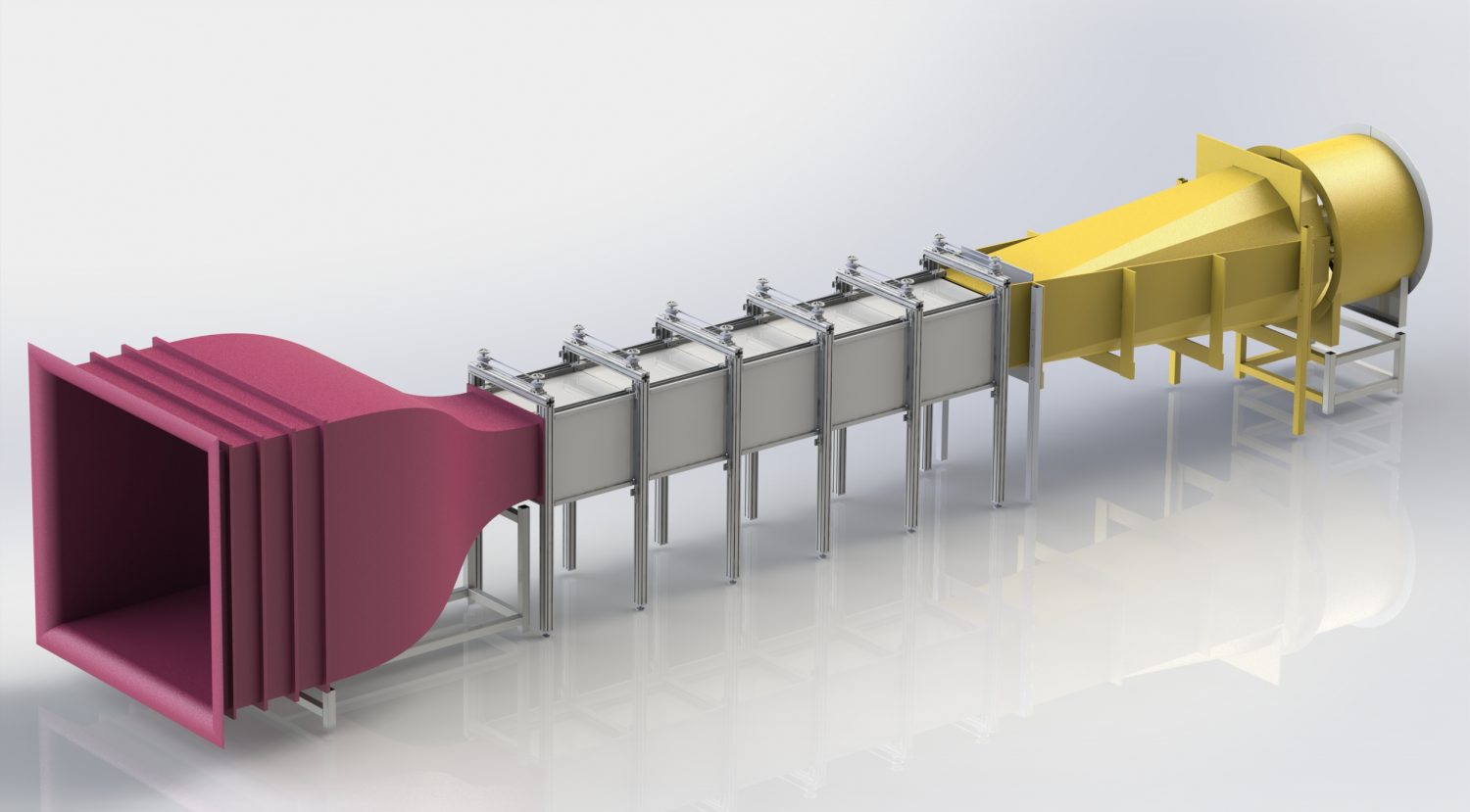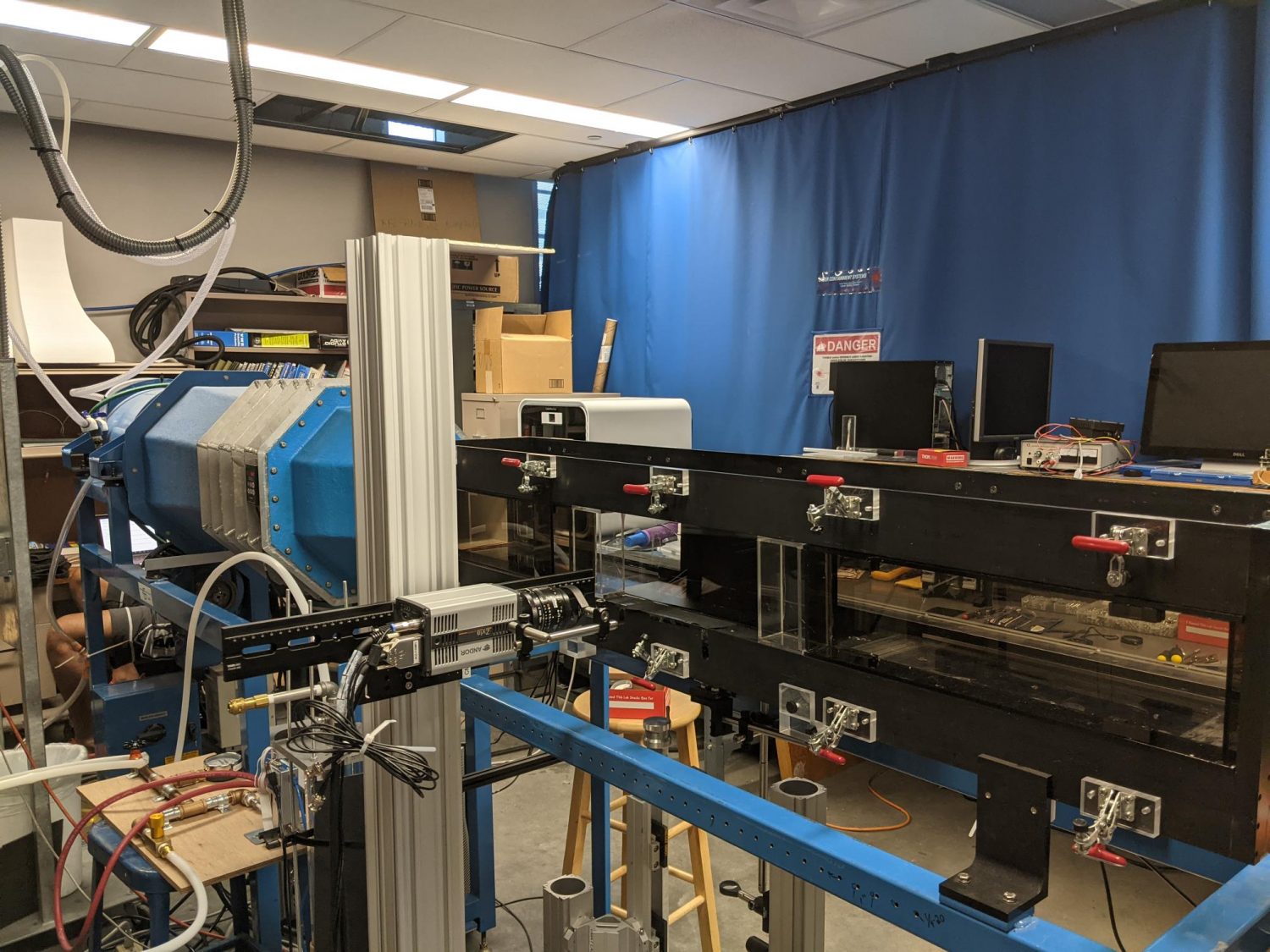Facilities and Diagnostics
Facilities
The ASU Boundary Layer Wind-Tunnel
Arizona State University Boundary Layer Wind-Tunnel has a 36 in × 24 in cm cross-section, where a turbulent boundary layer develops over a 5-meter flat-plate. The facility is specifically designed for well-resolved measurements of a high Reynolds number boundary layer structure ( up to 7000, based on wall shear-stress,
;
mm,
based on development length). Additionally, the free-stream velocity is adjustable up to 30 m/s, has a low turbulence intensity (< 0.1%) and an adjustable ceiling. The tunnel has optical access on all sides for implementing PIV and PLIF and pressure ports to measure pressure gradient.
The facility is currently under construction

The Small Wind Tunnel
Via a close collaboration with Prof. Ron Adrian’s Laboratory for Energetic Flow and Turbulence, CMAT lab performs research on the Small wind-tunnel that has a 6 in 6 in test-section and is 4 ft long. This facility is used to develop and demonstrate novel capabilities (dynamic roughness, dynamic pressure-gradient, etc.) before the mechanisms are scaled to the large Boundary Layer Wind-Tunnel. The test section is interchangeable to have a channel-flow or pipe-flow configuration.

Turbulent Jet Flow Facility
The Open-Loop Turbulent Jet Flow facility consists of an optically-accessible, 7.5 in-side octagonal tank. A salient feature of this facility is its ability to perform complex reacting experiments in canonical jet flow, where the two fluids react to produce one or more measurable scalars. The tank has an interchangeable nozzle at the center and can inject fluids up to 2 m/s from either a pressurized fluid tank (for long run times) or a controllable injector (for dynamic injection control). The facility is also capable of generating a gentle co-flow of up to 1 cm/s, driven from a separate pressurized reservoir. This prevents back-interactions, extends the duration of experiments, and enables reacting flow experiments without back-reactions. Outflow may be discarded into a drain when running with water, or it may be collected for disposal by ASU EHS when performing reacting experiments produce. The modular injector design can be modified to configure the interacting, twin jet tests.

Dynamic Surface System
The Dynamic Surface System is a large array of independently-controllable micro-servos that can impose lower order modes of a surface. This enables a precise and versatile control of lower-order topographical three-dimensionality in a rough surface to influence the role of the same on the boundary layer structure.
An -servo array is currently operational for the Small wind-tunnel and is undergoing testing. The design architecture of
-servo system for use in the Boundary Layer Wind-Tunnel is being finalized.

Diagnostic Capabilities
In addition to these experimental facilities, advanced laser-based diagnostics form the backbone of CMAT lab. The expertise includes complex Particle Image Velocimetry (PIV) implementations (planar and volumetric, high-speed and high-resolution), Laser-Induced Fluorescence (LIF, planar and line), and optical absorption spectroscopy (UV-VIS). A wide range of optics and opto-mechanics, translation stages, hotwire systems, synchronizers and DAQs are available to enable a simultaneous implementation of these as the flow demands.
The laboratory is equipped with the following major instrumentation:
- Quantel Q-Smart Twins 850 dual-head laser capable of 380 mJ/pulse/head of laser power at 532 nm and 90 mJ/pulse/head at 266 nm
- Bespoke backlit-LED light panels with three channels (red, blue, and green) for the jet-flow facility (under development).
- Andor Zyla 5.5 sCMOS camera with a 5 MP sensor that can record images at 100 Hz.
- LaVision Davis 10 and TSI Insight 4G PIV data acquisition and processing software with Hardware and GPU capabilities.
- Phantom V640 camera, with a 4 MP sensor that can record 12 bit images at 1.45 kHz
- Multiple New Wave Gemini PIV dual-head lasers capable of 200 mJ/pulse/head
- Multiple TSI PowerView 11 MP CCD cameras
Additionally, the lab is currently in the process of acquiring the following equipment:
- Multiple 65 MP sCMOS cameras for high resolution imaging
- Ocean Optics HR2000+ Spectrometer